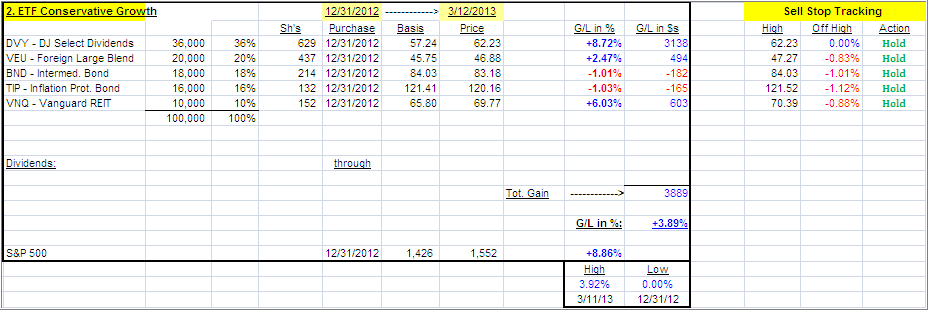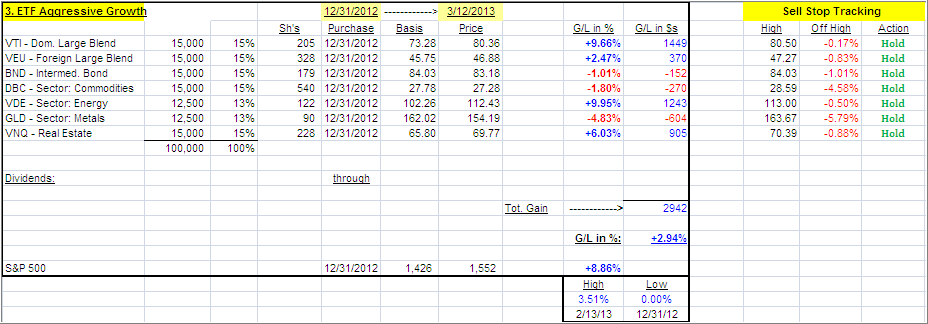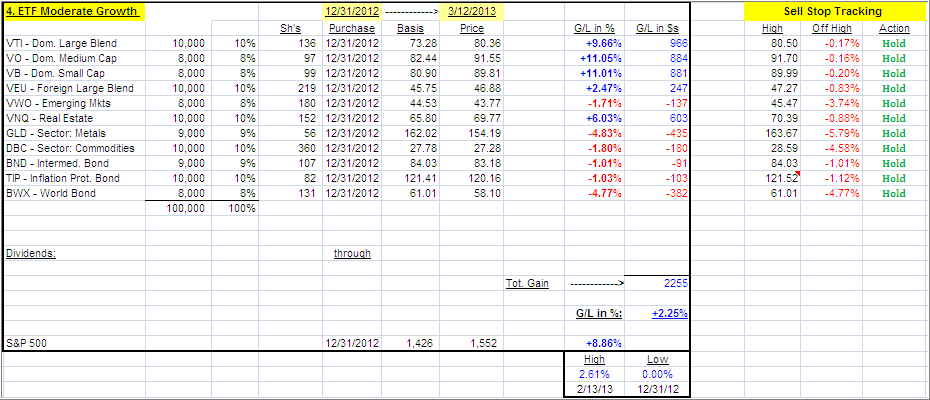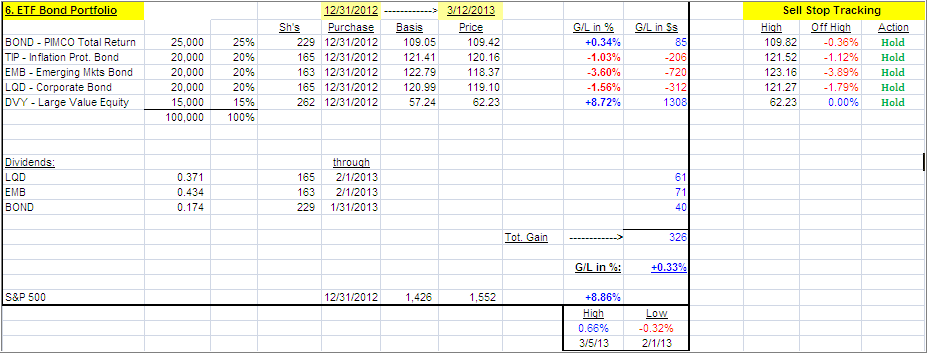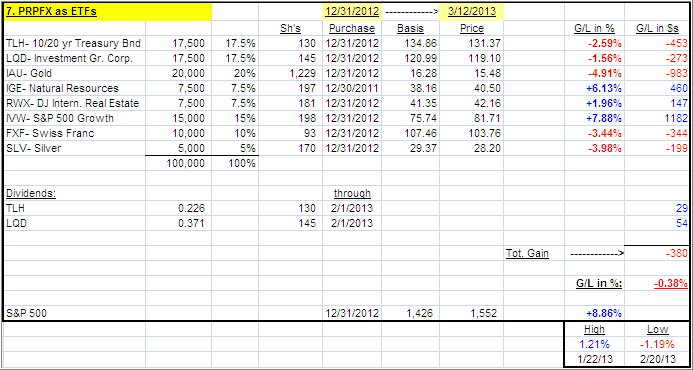More of the same as the equity index ETFs were pushed into the nosebleed section with the S&P 500 gaining seven days in a row before surrendering a jaw dropping 4 points yesterday. Nevertheless, this benchmark is within striking distance of following the Dow by taking out its 2007 high.
So far, this has not been the year of bond ETFs since their offsetting benefit during times of market stress has not been of any value, as the equity indexes marched straight north starting at the post-election November 2012 lows.
It’s a matter of fact some of the bonds/Treasuries such as BND, TIP and TLH have clearly pierced their long-term trend lines to the downside indicating higher rates. While I have kept these in the model ETF portfolios, in my advisor practice we have liquidated them. With the Fed being hell bent on pushing equities into the stratosphere via their open ended QE program, low volatility equity ETFs are simply a better choice until the trend reverses.
Last week, I listed my simple 3 rules for participating in this up trend. For the benefit of new readers, here they are again:
1. Invest only in the most liquid ETFs, such as I recommend in my HighVolume ETF list. When the inevitable trend reversal occurs, the exit doors will get very crowded very quickly and low volume products will produce much more slippage in price.
2. Select ETFs that are low in volatility so that a sudden pullback does not stop you out right away. Good candidates, which we own, are SPLV, XLP and DVY just to name a few.
3. Only invest if you are using trailing sell stops to control downside risk.
Below is the latest update for our Model ETF Portfolios:
1. ETF Trend Tracking Model Portfolio
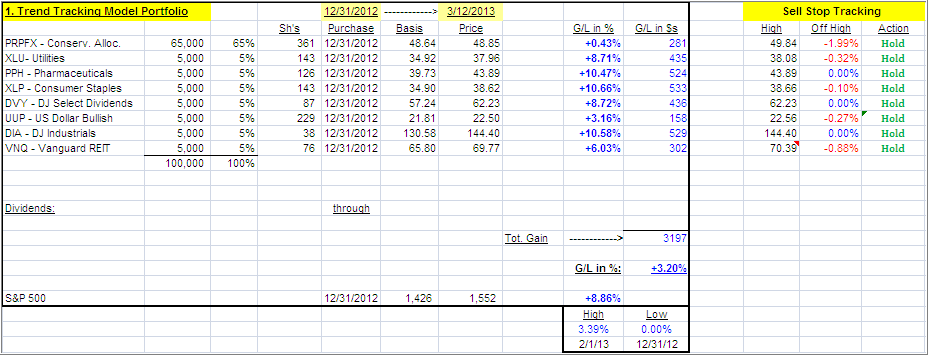 [Click on any table to enlarge]
[Click on any table to enlarge]
This is the portfolio allocation I have used predominantly in my advisor practice during the first half of 2011, although it lagged in 2012.
Around the PRPFX fund, when in buy mode, I add what I call boost components consisting of ETFs that can produce higher returns than my core holding, at least during bullish periods. When a market pullback occurs, the core holding should add an element of stability.
Nevertheless, as you know from my writings, anything I invest in involves the use of trailing sell stops, which are shown and tracked on the upper right of the table.
2. Conservative ETF Growth Portfolio
This portfolio, as are the following ones, would be typical of what is being used in the buy-and-hold community, as you can see by the 40% allocation to various bond ETFs. If you are conservative, this simple combination could work for you, but I still recommend the use of the trailing sell stops during these uncertain times.
3. Aggressive ETF Growth Portfolio
What makes this one aggressive is the small 15% allocation to bonds. If you have an aggressive streak in your personality, you could consider this one. If you use my recommended sell stop discipline, you know exactly ahead of time what your downside risk will be.
4. Moderate ETF Growth Portfolio
I call this one moderate growth, because of the higher allocation to various bond ETFs (27%) than in the aggressive set up above. It is also more diversified domestically.
5. ETF Income Portfolio
This is as simple as it gets, but this model held up well in 2012 and turned out to be the top performer out of the seven I feature. Only two ETFs were stopped out during the past year, and the proceeds were subsequently re-invested as the upward trend emerged again.
6. ETF Bond Portfolio
Many readers have asked for an ETF Bond portfolio, which I have set up in this section; it replaces the old Ivy Portfolio.
With the global slowdown underway, bonds continue to have upside potential until higher interest rates caused by inflationary tendencies will bring this rally to an end. Fed policy is promoting lower rates for another couple of years or so, but market pressures due to unintended consequences could bring this trend to a sudden end, which is why the use of my recommended sell stops is critical.
Even though this is a bond portfolio, I believe some small equity exposure (DVY) is vital should the relentless pumping of equities continue.
7. The ETF Equivalent of PRPFX
As posted recently, I have created and back tested the ETF equivalent of my favorite mutual fund, PRPFX, which is a core holding in my #1 Portfolio. If you missed it, you can read the announcement here.
Take a look at the combination of ETFs:
Since these 8 ETFs represent only one fund, namely PRPFX, we can apply a different exit strategy. For that purpose, I will not track the high points made for each ETF, as with the other 6 models, but measure my 7% drop from the high point this entire portfolio has made.
Alternatively, you can sell this entire portfolio once our domestic TTI has crossed into bear market territory or hold on to only those positions that are maintaining upward momentum. That solves the issue of “what to buy” if you had liquidated 100%.
(ETF trading costs are not included in these portfolios demonstrations. They are intended to show market effects on different scenarios only as an educational tool)
To repeat, the key to selecting a portfolio from the above list is not just performance. Personally, I’d rather lag a little on the upside but have some assurance that I will also lag when the downside comes into play.
I will update these portfolios every Wednesday.
Quick Reference:
Disclosure: I may have personal and/or client holdings in some of the funds/ETFs discussed above
Contact Ulli
